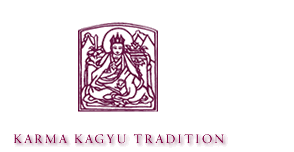Informationen zur Geschichte der Karma Kagyu Schule des tibetischen Buddhismus und aktuelle Aktivitäten des 17. Karmapa Thaye Dorje

Buddhism has its roots in India. The historical Buddha gave a great variety of teachings in order to accommodate the different capacities of beings. Although he taught only orally, his early disciples recorded his instructions in writing and passed them on in their original form. Later on, Buddhist masters wrote many treatises that explain the Buddha’s teachings. The emphasis was on the authentic and accurate transmission of the teachings. Throughout the centuries, as disciples became teachers, different lines of transmission came about, each with their own characteristics. Approximately one and a half millennia after the passing away of Buddha Shakyamuni, Northern India was home to a number of great Buddhist masters, holders of many Buddhist transmissions and key instructions to accomplish meditation. Among them was the master Tilopa (988-1069), who held four special esoteric Buddhist lineages. In Tibet these were later referred to as “ka bab shi’i gyu pa”, i.e., “the lineage of the four transmissions” (“ka bab” = tradition; “shi” = four and “gyu pa” = lineage). This was abbreviated to “ka-gyu”, thus giving the name “Kagyu” to this school. Tilopa gave his special transmissions to his disciple Naropa (1016-1100). Other prominent Indian figures for the teachings transmitted in the Kagyu school were the masters Saraha and Maitripa. They were famous for their special instructions of Mahamudra and mental non-engagement, teachings which Tibetan masters later on skillfully continued to transmit until the present day. Buddhism comes to Tibet A complete transmission of these teachings came to Tibet starting in the 8th century. The Tibetan king Trisong Detsen invited two Indian Buddhist masters to Tibet – Guru Rinpoche (Padmasambhava) and Shantarakshita – and authorised the translation of the teachings from Indian to Tibetan. This was the start of the Nyingma or “Old” tradition. During the 11th century there was a second period of translation which involved the revision of earlier terminology as well as new translations. The traditions that base their transmission mainly on that period are referred to as the Sarma traditions, the “New traditions”. Of these, the Kagyu, Sakya, and Gelug are the best known. The Karma Kagyu tradition is a subschool within the Kagyu tradition. Like all Tibetan Buddhist schools, it traces itself back to Indian Buddhist masters who were active at the time when Buddhism found its way to Tibet. The Tibetan translator Marpa (1012-1097) learned in India from both Naropa and Maitripa and brought all these transmissions back to Tibet, mastered them and transmitted them to, among others, his disciple Milarepa (1052-1135). With the latter’s student Gampopa (1079-1153), the Kagyu school branched off into a number of subschools, a major one being the Karma Kagyu lineage which was named after its founder, the first Karmapa Dusum Khyenpa (1110-1193). With the recognition of Karma Pakshi (1204-1283) as the 2nd Karmapa, the first line of reincarnated lamas of Tibet came into being. Ever since, the spiritual heritage of the Karma Kagyu tradition, with its special focus on Mahamudra meditation, was transmitted through the Karmapas and the lineage … Continue reading The Kagyu lineage
The 17th Karmapa: Official website of Thaye Dorje, His Holiness the 17th Gyalwa Karmapa
